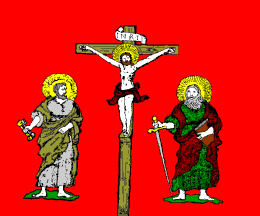 image by Jaume Ollé, 7 July 2001
image by Jaume Ollé, 7 July 2001
Last modified: 2017-09-04 by rob raeside
Keywords: vatican | holy see | catholic | pope |
Links: FOTW homepage |
search |
disclaimer and copyright |
write us |
mirrors
On this page:
See also:
The first attested Papal flag was red with white cross, dated
probably from c. 1195. In 1204 for sure (and perhaps before) it's
attested the red flag with white cross containing white keys. The
first available image is from 1316. The flag is rectangular with
the fly rounded in the corners and swallow tailed in center and
has four white keys, one in each quarter. The four keys were the
keys called of St Peter. About 100 years later, a similar flag is
attested on red cloth without white cross. In next centuries a
red flag with keys or religious motives seems to be in use.
Jaume Ollé, 30 April 2003
Since the creation of Vatican City in 1929, I am not aware of
any full-size "personal" flags for the popes being used
at the Vatican. There were, however, flags for three different
papal corps which bore each successive pope's personal arms.
These corps were all disbanded in 1970 by Paul VI. The Palatine
Honor Guard was an honorary body which served at papal
ceremonies, and carried a yellow-white vertical bicolor charged
with the pope's personal arms in the center, and ornamentations
around the corners. I have a personal photo of the Palatine color
from the pontificate of Pius IX, from the Vatican Historical
Museum at the Lateran Palace in Rome. Its pattern was repeated
for each pope until 1970, but with the new pope's arms. The Noble
Guard also attended the pope in an honorary capacity. Their color
was white, with the pope's personal arms in the center, the name
of the corps, and golden brocade along the edges. The color of
the Pontifical Gendarme Corps was blue with the pope's arms in
the center, and the name of the corps. It has since been replaced
by the "Vigilanza Vaticana," the Vatican City police
force (which does not have its own color).
Rev. William M. Becker, STD, 30 June 2004
From <www.heraldica.org>:
""Flag of the Papacy by Elliot Nesterman
"The flag of the Vatican is yellow and white. However it has
been so only since 1808, at which date, Napoleon amalgamated the
pontiff's army into his own and so the Pope, Pius VII, thought
that new colors were necessary. He chose yellow and white. These
colors were used for various flags of the Pontifical State from
their approval in 1825 until the State was incorporated into
Italy in 1870. When the state was revived as Vatican City in 1929
the yellow and white flag was reborn. The modern flag was first
officially hoisted on June 8, 1929. (Keep in mind that the
conventions of flag use differ significantly from armorial
conventions regarding the shield proper.) "It is true that
the flag is now often shown with the keys and tiara over the
division between yellow and gold. As a result, they are hard to
distinguish, and have been rightly criticized by Bruno Heim. This
flag does not, per se, constitute a violation of the
"tincture rule" in heraldry. Flags are not subject to
the same rules, and even Old Regime France used a semis of
fleur-de-lys gold on a field of argent as the flag for its Navy.
"Prior to the modern 19th century flag, there existed
something called the papal banner, which has a very long and
confused history. According to Galbreath, Leo III (pope from 795
to 816) gave Charlemagne a banner which is represented in a
contemporary mosaic of the Lateran triclinium: "it is a
green flag of the gonfalon type with three tails, with numerous
gold dots and with 6 disks coloured red, black and gold, which
doubtless are meant to represent embroidery." This banner
was the vexillum of the Roman militia, not really the papal
banner, and in any event disappears from history until the
mid-11th c., when popes take the habit of giving specially
blessed flags for specific military campaigns; one of which was
that of William the conqueror. Parallel with this flag of the
gonfalon type we find the persistence of the classical signum, a
staff tipped by a cross with a short oblong of red cloth fastened
to a transverse bar below. Of the various banners given out in
that period (1044, 1059, three around 1065, 1087, 1098, 1106,
1114) nothing is known except from the tapestry of Bayeux. In the
tapestry, William the Conqueror (to whom we know from elsewhere
that a papal banner was given) is shown with a banner of Argent,
a cross or between four objects (cots? crosslets?) sable.
"The cross is mentioned on flags with the second crusade
only (1147-49). A contemporary depiction of the emperor Frederic
I as crusader (1190) shows him with a white shiled bearing a gold
cross. In 1203 Innocent III sends a flag to the tsar of the
Bulgars with a cover-letter; the flag bore a cross and the keys
of St. Peter. This flag reappears in 1316 when the town of
Viterbo was allowed to add the vexillum of the Church to its
arms: it is depicted as a red oblong flag with two tails, with a
white cross cantonned by four upright white keys. By the 16th c.,
the simpler and more familiar version of the arms of the Church
(keys gold and argent on a field gules) had won out.
"Sources: "Donald L. Galbreath: Papal Heraldry.
Cambridge, 1930; Heffer and Sons. "Bruno Heim: Heraldry in
the Catholic Church: Its Origins, Customs and Laws. Gerrards
Cross: Van Duren, 1978. "Baron du Roure de Paulin:
L'Héraldique Ecclésiastique. Paris, 1911; H. Daragon."
Santiago Dotor, 18 February 2005
 image by Jaume Ollé, 7 July 2001
image by Jaume Ollé, 7 July 2001
This flag with Christ in the cross, St Peter and St Paul was
dated 1669, reflected accurately a pattern of flag used by the
Papal States ships.
Jaume Ollé, 30 April 2003
Dated in 1771, the British Enciclopeadya reported a red flag
bearing a cross over a stone (near the hoist) and a bear (looking
to hoist) at fly. I believe that this is a wrong reconstructed
flag. According to this report, the red background was used in
the XVIII century, but the change to red and yellow flag seems to
be attested already in the previous century. The flag in the Navy
and Holy See from XVII century seems to be red and yellow
vertical (or horizontal?) bearing sometimes the tiara and the
keys. This flag (described as bicolor without ornaments) was in
use in1798 when french took Rome. .Becker, in Flag Bulletin 119,
states that in reality there was not a flag (like the modern
concept), but mainly cockardes of red and yellow, and he doesn't
mention the keys. Becker says that was in use until 1808 when
Napoleon took Rome.
Jaume Ollé, 30 April 2003
The colours of Rome seems to be red
and yellow in vertical arrangement to this day. Don't know if
these Papal flags are their origin or if it is the other way
around (or even if it could be differentiated at the time). While
Vatican changed its colours, the Rome sticks to them to this day,
indeed maybe in somewhat unusual shaes, but yet.
Željko Heimer, 5 May 2003
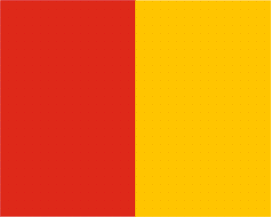 image by Jaume Ollé, 30 April 2003
image by Jaume Ollé, 30 April 2003
Pre 1808
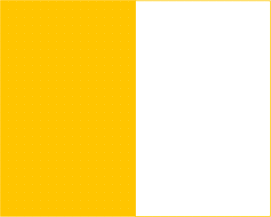 image by Jaume Ollé, 30 April 2003
image by Jaume Ollé, 30 April 2003
From 1808
On 16 March 1808, Pope Pius VII ordered the new cockade:
yellow and white, probably derived from the colors of the keys of
St. Peter, but is not established that the change is related with
any imposition from Napoleon. A good source for the period before
1808 seems to be: Luigi Zara, La bandiera Pontificia, Rivista
Araldica (Roma 1929) Vol. 27, pag. 134 & 135.
In fact the use of the colors in flags is not attested.
Officially, there were only cockades in use. The last colors were
used in flags only after the Vienna Congress of 1815 bearing the
tiara and keys (in the center?). The flag is pictured in
"Les Pavillons des Potences Maritimes" (Paris, 1819),
however, not in the original edition, but in a correction issued
in a unknown date later than 1819. This flag was for merchant
ships and for fisherman boats. Simultaneously were used other flags
(is not clear what others, but seems to be clear that the pattern
dated 1669 was in use, surely now - after 1808 - with white
background). Cardinal Chamberlain established the yellow and
white flag with keys and tiara as the single merchant flag in 17
September 1825. The use was moved to land when, in 1831, the
colors were adopted by a army body. The book "Insigne
militaire preunitaria italiana" show several examples of
flags. The crossed keys and tiara patterns were similar but
different from the current ones.
Frequently used between 1808/15 and 1825/31 at least, was a plain
white flag bearing the keys and tiara. This seems to be used by
the military navy and army on land as alternative design or as
old design moved to white.
Jaume Ollé, 30 April 2003
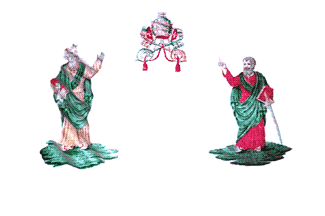 image by António Martins-Tuválkin, 19 June 2005
image by António Martins-Tuválkin, 19 June 2005
The tiny papal navy flew a white ensign with a small
tiara-keys emblem between the figures of Ss. Peter and Paul.
Rev. William M. Becker, STD, 30 June 2004
This may be the same as the illustrated in Steenbergen
[Steenbergen (1862)] as 523.
António Martins-Tuválkin, 19 June 2005
The Vatican Historical Naval flag is described at
http://vatflag.tripod.com as the "Papal
States war ensign for the Immacolata Concezione (1870), Flags of the World
website". This website is maintained by William Becker.
Esteban Rivera,
14 June 2011
At J.W. Norie / J.S. Hobbs: Flaggen aller seefahrenden
Nationen, 1971 [Norie/Hobbs
(1971)] (original print 1848):
160 Papal Standard:
White, charged with arms which are to elaborate to derive from a
flag image. Let me just say golden keys and tiara feature in
them, as well as the colour blue and the word "PAX".
(The Vatican State?).
161 Roman Merchant:
As current flag in a different style. Both keys appear to be
yellow, though.
Peter Hans van den Muijzenberg, 12 November 2001
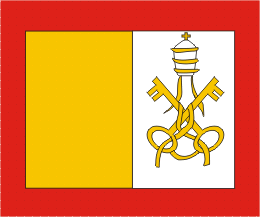 image by Jaume Ollé, 27 January 2003
image by Jaume Ollé, 27 January 2003
No. 126 - Papal States, flag of destress, also related to
require a pilot.
Source: Steenbergen (1862).
Jaume Ollé, 27 January 2003
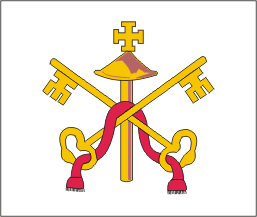 image by Jaume Ollé, 30 April 2003
image by Jaume Ollé, 30 April 2003
No. 520
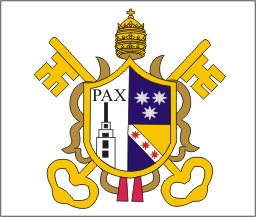 image by Jaume Ollé, 30 April 2003
image by Jaume Ollé, 30 April 2003
No. 521
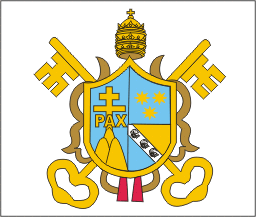 image by Jaume Ollé, 30 April 2003
image by Jaume Ollé, 30 April 2003
No. 521 (corrected - 1815-1823)
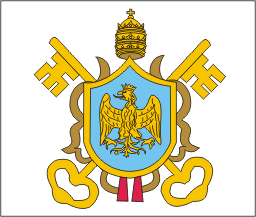 image by Jaume Ollé, 30 April 2003
image by Jaume Ollé, 30 April 2003
No. 521 (corrected - 1823-1829)
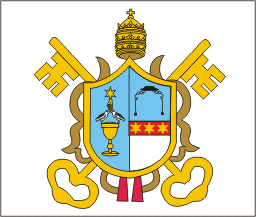 image by Jaume Ollé, 30 April 2003
image by Jaume Ollé, 30 April 2003
No. 521 (corrected - 1831-1846)
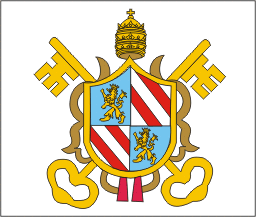 image by Jaume Ollé, 30 April 2003
image by Jaume Ollé, 30 April 2003
No. 521 (corrected - 1846-1870)
 image by Jaume Ollé, 30 April 2003
image by Jaume Ollé, 30 April 2003
No. 522
The Papal fortress and military navy belonging to Pope or with
the Pope abroad, must use the flag bearing the Papal arms, keys
and tiara. The example is illustrated in Steenbergen (1862) under number
521. This flag is slightly wrong because some details of the Pope
arms are bad represented. Therefore I add reconstructed images of
the same flag from the respective dates (1815-23, 1823-29,
1831-1846, and 1846-70). Steenbergen mentioned it as "State
and Navy" (standard). The ships from the Papal states that
wasn't belonging to the Pope, and merchant ships, used a white
flag with St Peter and St. Paul pictured by Steenbergen as 522. I
believe that this flag was suppressed in 1825 but was used for
some years more. Periodically the Popes changed, always by death
of the previous one. Until a new Pope was designated, there was a
period (between some weeks and some months) of
"vacation". The flag attached as must be the State flag
and Navy ensign during the vacation period. Steenbergen captioned
it as "Rome, vacation of the Holy see". This flag was
in use in 1823, 1829-1831 and 1846 at least.
Jaume Ollé, 30 April 2003
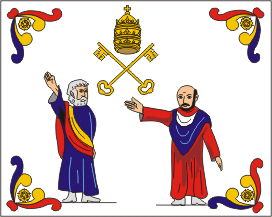 image by Jaume Ollé, 30 April 2003
image by Jaume Ollé, 30 April 2003
No. 523 - Papal Navy ensign
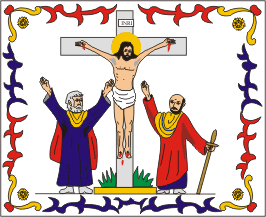 image by Jaume Ollé, 30 April 2003
image by Jaume Ollé, 30 April 2003
No. 524 - Holy Church
Both flag are supposed to be in use until 1870. Probably
already in use before 1800. Steenbergen stated that there are many
variations of them, in drawing and colours.
In 1870, the Papal states were annexed to the Italian Kingdom.
Jaume Ollé, 30 April 2003
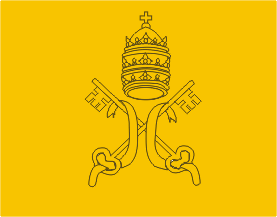 image by Jaume Ollé, 21 September 2003
image by Jaume Ollé, 21 September 2003
No. 997 - Papal States, port captain.
Source: Steenbergen (1862).
Jaume Ollé, 21 September 2003
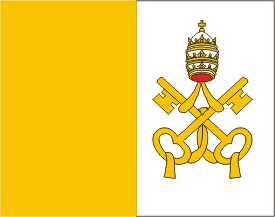 image by Jaume Ollé, 13 October 2003
image by Jaume Ollé, 13 October 2003
No. 1063:
a) Papal States fishermen
b) Papal States Merchantmen at festival days only
Source: Steenbergen (1862).
Jaume Ollé, 13 October 2003
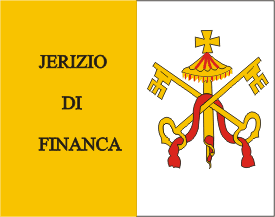 image by Jaume Ollé, 13 October 2003
image by Jaume Ollé, 13 October 2003
No. 1064 - Papal states. Duties of impost and export and
treasury (The inscription means: "Reverende Camera
Apostolica").
Source: Steenbergen (1862).
Jaume Ollé, 13 October 2003
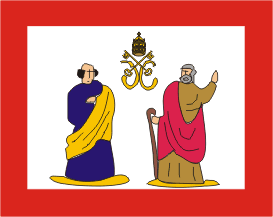 by Jaume Ollé, 14 November 2003
by Jaume Ollé, 14 November 2003
Addition No. 125 - Papal states flag of honor 2nd class,
Captains that have made a determined number of voyages in the
great course.
Source: Steenbergen (1862).
image Jaume Ollé, 14 November 2003
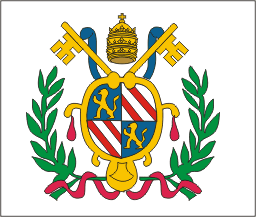 image by Jaume Ollé, 16 November 2003
image by Jaume Ollé, 16 November 2003
Addition No. 525a - Papal States, Pope flag; Papal states on
all fortress; Papal states, at the foremast on the festival days
Source: Steenbergen (1862).
Jaume Ollé, 16 November 2003
 image by Ivan Sache, 11 February 2002
image by Ivan Sache, 11 February 2002
Peter Hans van den Muijzenberg wrote: "At "Nouveau
Petit Larousse Illustre" (1924), the Holy See flag appears
to be with equal lengthwise stripes, white over yellow".
The very same Vatican flag is shown in "Grand Larousse
Illustré du XXe siècle" (1929). Since all flags are shown
there with 3:4 proportion, I have used a more standard 2:3
proportion for my image.
Ivan Sache, 11 February 2002
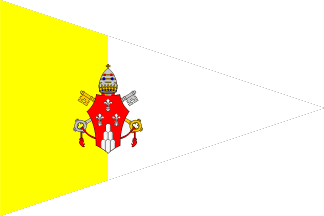 image by Željko Heimer, 30 June 2004
image by Željko Heimer, 30 June 2004
The car pennant of Pope Paul VI, as used in 1970.
Rev. William M. Becker, STD, 30 June 2004
A yellow-white vertically divided pennant with the papal
personal coat of arms in the middle: Gules three fleurs-de-lis
argent one and two and coupeaux of six in base. Crowned with a
tiara and supported by two keys in saltire, wafts to top and
outwards, the one with the waft to dexter or and the one to
sinister argent, tied together with a cord with tassels gules.
Paul VI name before he became pope was Jean-Baptiste Montini
(1897-1978), and the coupeaux may be referring to his family name
(are these based on the family coat of arms ?)
Željko Heimer, 30 June 2004
According to Galbreath's book "Papal heraldry" [Galbreath (1972)], Montini assumed
the canting arms when appointed archbishop of Milan in 1954.
Blazoning of the arms in Galbreath
(1972): "Gules, issuant from the base a mount of six
coupeaux and in chief three fleurs-de-lis, one and two
argent."
M. Schmöger, 30 June 2004
Paul VI abolished two bodies, the Noble Guard and the Palatine
Guard, leaving only the Swiss Guard.
These two groups must have had flags, too. One example, not very
clear though, at <www.globalizzazione2000.it>.
Jan Mertens, 21 June 2005
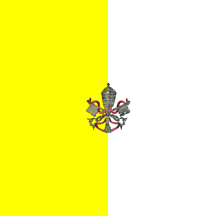 image by António Martins-Tuválkin, 4 October 2007
image by António Martins-Tuválkin, 4 October 2007
.gif) image by António Martins-Tuválkin, 4 October 2007
image by António Martins-Tuválkin, 4 October 2007
From eBay: An
Antique Flag of the Vatican City with the Papal Coat of Arms
embroidered with real silver and gold threads. This Flag has the
Coat of Arms of the Holy See bisecting the yellow and white.
Antique market near Bassano Italy, It seems that a family he knew
in Rome was moving and needed to divest themselves of their Grand
Uncles’ vestments. The uncle had been a Cardinal."
Bill Garrison, 30 June 2007
The emblem takes only ~1/4th
of the flag's height.
António Martins-Tuválkin, 4 October 2007